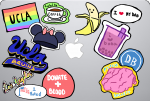Human beings, unlike laptops, are not neutrally monochrome.
Tech companies devised the laptop on the premise of efficiency and mobility and as a result, its appearance is sleek and simple.
Since then, the computer has become a more personal item. We went from being disconnected to our devices to keeping them – as the name implies – sitting in our laps.
As I wandered into the multiple coffee shops in Westwood, the laptop-as-an-extension-of-the-body phenomena was crystal clear. As add-on body parts, laptops are adorned and personalized, shaped and branded.
They not only shout out where their owner is from or what they like to eat, but also the places they’ve traveled, the sports team they subscribe to, their political beliefs and so much more. Students coat the stainless steel exterior of their computers with stickers, rebelling against the idea of being ordinary.
When people sit in crowded coffee shops, hunched over their laptops with headphones blocking out the rest of the world, it seems like social interaction is impossible. Laptop stickers, however, could provide a new alternative.
Still, trying to talk to people about their personalized designs was incredibly intimidating. The laptops seemed to work as an isolating barrier, a fort that I felt insecure about pushing through – especially when talking to complete strangers.
Laptop stickers often serve as art projects, creative outlets for students who refuse to have dull run-of-the-mill personal belongings.
Soli Rachwal, a third-year gender studies student, has an artistic collage consisting of maps, old movie posters and a large ostrich sticking out its tongue. Her funky creation is not only a reflection of her artistic skills, but reminds her of friends and family.
“My dad is a graphic designer, and before the internet they had these books with different-themed images. My friends came over one day and we cut some of them up. It was very fun and I think it turned out pretty cool. I always get a lot of compliments on it,” Rachwal said.
Some laptop designs take an artistic route, but the same cannot be said for everyone. Sometimes, the sticker selection is not carefully curated, but instead serves the practical purpose of recognition in a sea of similar-looking products.
This is a case for Aishwarya Natarajan, a third-year molecular, cell, and developmental biology student. She said that she does not think about the stickers she has, but she instead collects them randomly in order to personalize her belongings.
“Most of the stickers are things I get at work, on Bruinwalk or things my friends give me. I have never gone out of my way to buy stickers or anything like that. I use them to be able to recognize my water bottle since there are so many Hydro Flasks ,” Natarajan said.
Whether meticulous, artistic or random, these stickers enhance our personal belongings, perhaps even helping to give our possessions a second life.
“It’s such an old bottle that was getting chipped, so I just kind of covered it up with stickers instead of buying a new one,” Natajaran said.
Interestingly, I felt like I knew a lot about the students I talked to after chatting for only a couple of minutes. Whether we chatted about their places of work, political beliefs, religions, close relationships, or that they simply happened to walk down Bruinwalk on a certain day, it became clear that these stickers encourage conversation.
They provoke curiosity, and a desire to learn about those around us. In a school of more than 30,000 undergraduates, this bid to reach out to each other is extremely valuable.
When I spoke to Sophie Kehl, a first-year geology student about her stickers, not only did I learn about her love for environmental awareness – and K-Pop boy bands – but I also was pushed to see the things we had in common. Like me, one of Kehl’s greatest achievements was her admission to UCLA. She chose to celebrate it with a blue and gold sticker that covered almost all of her laptop cover.
“I decided to start decorating it when I got into UCLA and put that first sticker as a sign of commitment. I guess I always loved it when I saw people with a bunch of stickers and so I decided to do it myself,” Kehl said.
As I was getting ready to leave one of the coffee shops, I was feeling very satisfied with the conversations I had. Even though they were nothing out of the ordinary, they represented an act of bravery for me – I was able to get through the fort-like barrier of our technology and approach fellow members of the UCLA community as human beings.
With everyone hidden behind the top lid of their laptops, it can be hard to see the faces of people around us at times. As the laptop cover takes over as the face we show the world, it makes sense that we want to adorn it – to make it more human and less machine.
As I was packing up my own laptop, Rachwal turned the question on me.
“I’m curious now, what do you have on your laptop?” she said.
